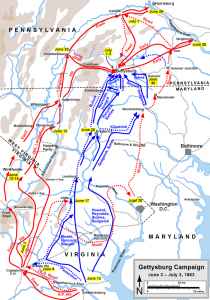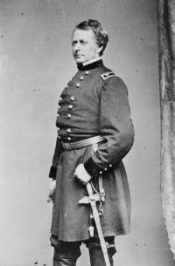“One of the Hardest Marches”: Two Lieutenants & The Gettysburg Campaign, Part 3

Part 1 and Part 2 are available.
Heat and dust became common themes in soldier’s diaries during the Gettysburg Campaign. Lieutenants Dooley and Rhodes offered no exception. In fact, the difficulties of the march proved so great that Rhodes penned only one entry on the third week of the campaign. Dooley did not write a dated entry at all, though he wrote generally about the march sometime in those weeks or later when he added to his journal to fill in the blank periods.
Interestingly, both of these lieutenants and their regiments moved at the tail ends of their respective armies. The 1st Virginia still had not crossed the Potomac even though the advance of Lee’s army had been terrifying Pennsylvanians. The 2nd Rhode Island in the Army of the Potomac’s VI Corps marched and waited in northern Virginia also.
In this post, you’ll find primary source excerpts from Lieutenant John Dooley of the 1st Virginia and Lieutenant Elisha Hunt Rhodes, and some campaign highlights to explain the happenings that these two officers did not know about. I promise that their journal entries get more exciting and plentiful in the final week leading to Gettysburg!
June 17 – Battle of Aldie in Loudoun County, Virginia, occurs as Union cavalry and Confederate cavalry clash; Union troopers attempt to probe the Confederate “screen” to discover Lee’s route and objectives. The Army of Northern Virginia started crossing the Potomac on June 15 and continues crossing until June 25.

June 18 – Pennsylvanians are responding quickly to Governor Curtain’s call for emergency troops.
June 19 – At the Battle of Middleburg, General J.E.B. Stuart’s Confederate cavalry drives back Union cavalry under Col. J.I. Gregg
June 20 – Confederate General Robert E. Lee sends orders for Southern forces in western Virginia to keep any Union troops in the area occupied to prevent reinforcements and requests the promised brigades from Richmond for his own army.
June 21 – The Battle of Upperville hurls cavalry and infantry against Stuart’s Confederate cavalry protecting Lee’s line of march. The Rebel troopers prevent a break through, but are forced into Ashby’s Gap.

June 22 – Confederate General Robert E. Lee orders his Second Corps to advance into Pennsylvania and divide into three columns for faster movements and better ability to gather supplies.
June 23 – Union General Joseph Hooker visits the White House and meets with President Lincoln; their discussion goes unrecorded.
John Dooley, 1st Virginia Infantry
Terrible had been that march along the scorched and blazing plains of Virginia. Angry was the glare of the sun during those fearful days of June, as it flashed upon our ranks and fiercely smote again and again the burning temples of our fagged and fainting soldiers. Choking, blinding were the clouds of dust that rose from beneath the army’s unsteady tread; parching was that unquenchable thirst which dried the tongue to its very roots. The men fell by tens, twenties, nay by hundreds along the dusty roadsides. Such days as these prove the true soldier, and he who falters not in the long and wearisome march will not be absent from the charge.
Elisha Hunt Rhodes, 2nd Rhode Island Infantry
Fairfax Station, Va., June 17th 1863
We are now five miles from Fairfax Court House and about twenty miles from Washington. Last Saturday night [June 13] the Rebels opened fire upon us but were silenced by our Batteries. On a hill on the north side of the Rappahannock River our people had mounted a 100lb. rifle gun. It took several days to get the gun in position. Just before dark its only shot was fired. The recoil upset the gun, and as the Army was to move, the gun was sent to the rear. This shot passed over the river, over our heads, and into a Rebel fort on the hill near Fredericksburg. It burst and sent up a cloud of sand and dust. The noise it made was like that of a railroad train, and when it struck the whole army cheered. It rained, thundered, and lightened and in the midst of it the 6th Corps recrossed to the north side again. Here we rested until the next morning when we marched to Stafford Court House, which place we reached in the afternoon. Here we remained until 9 P.M. when we moved on and reached Quantico Creek at a place called Dumfries on Tuesday noon [June 16], almost dead from the heat. I never suffered more in my life than I did on this march. We rested at Dumfries until midnight when we started again and reached this place last night. It has been one of the hardest marches that we have ever known. Fairfax Station is on the railroad. We hear that the Rebel Army is in Pennsylvania. If this is so I trust we shall be able to catch them and end the war. Our address is 2nd Brigade, 3rd Division, 6th Corps.
To be continued next week…
Sources:
Rhodes, Elisha H. edited by Robert H. Rhodes. All For the Union: The Civil War Diary and Letters of Elisha Hunt Rhodes. Orion Books, NY: 1985.
Dooley, John. edited by Joseph T. Durkin. John Dooley, Confederate Soldier: His War Journal. University of Notre Dame Press, IN: 1963.